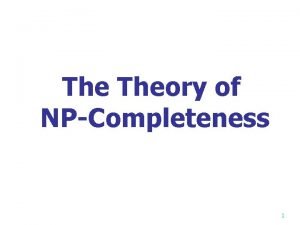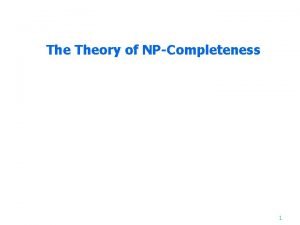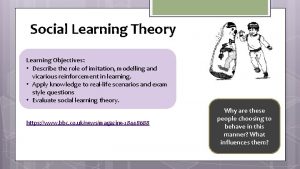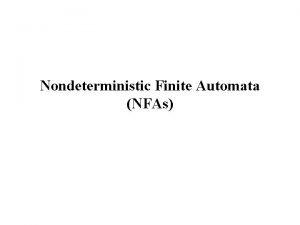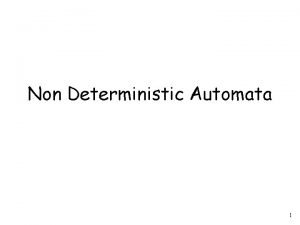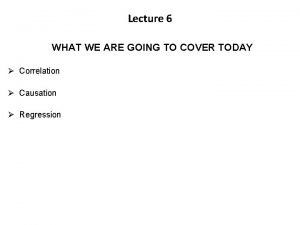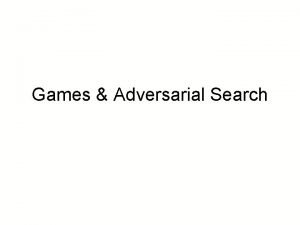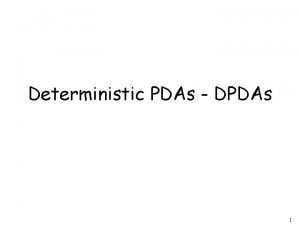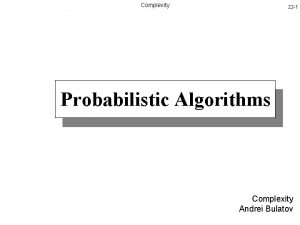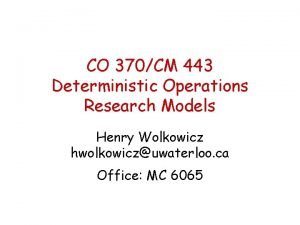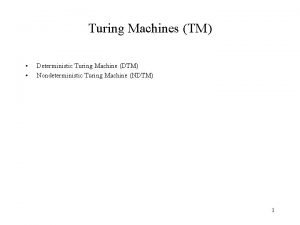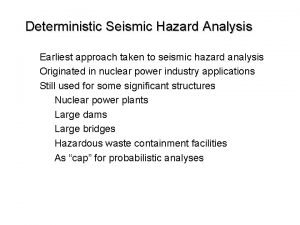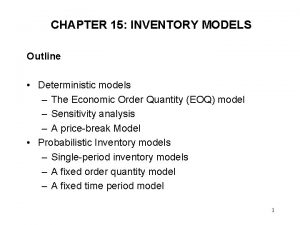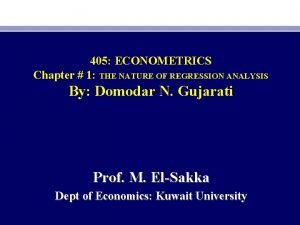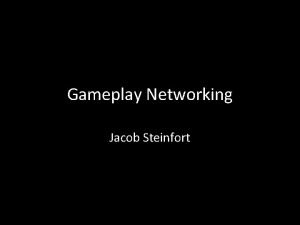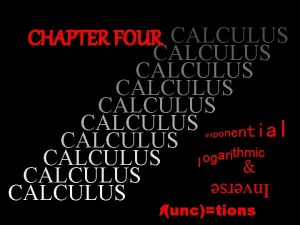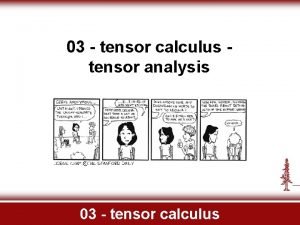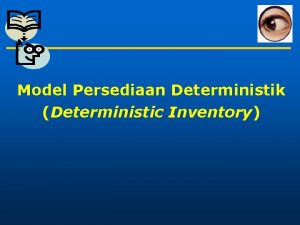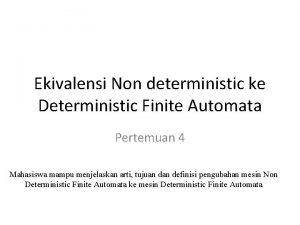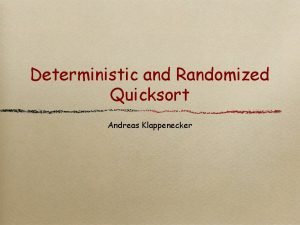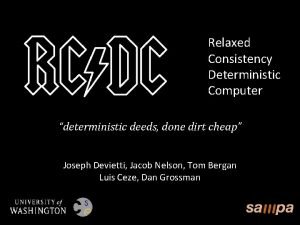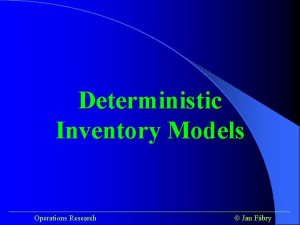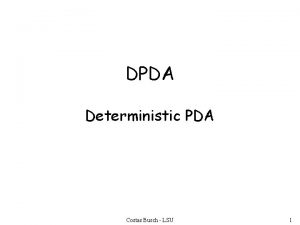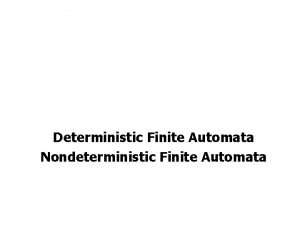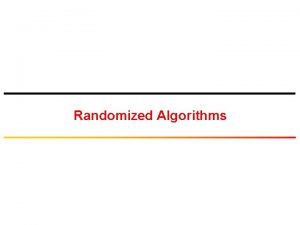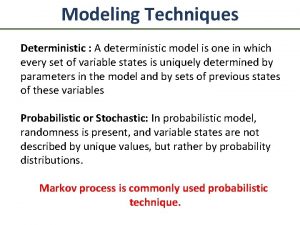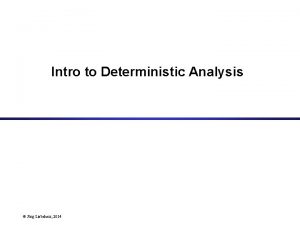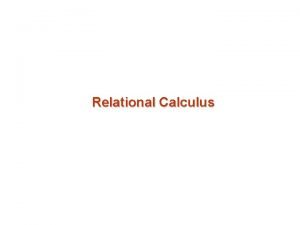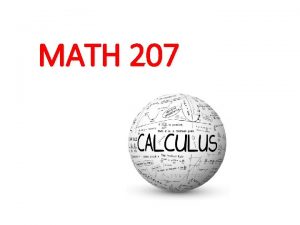Intro to Deterministic Analysis leftcontinuous Deterministic network calculus












![Left-continuous vs. right-continuous A(t) considers arrivals in (0, t] left-continuous A(t) considers arrivals in Left-continuous vs. right-continuous A(t) considers arrivals in (0, t] left-continuous A(t) considers arrivals in](https://slidetodoc.com/presentation_image/3e1531d954a2d550313ea78debf92be2/image-13.jpg)






- Slides: 19

Intro to Deterministic Analysis left-continuous

• Deterministic network calculus: – Theory for obtain worst-case (=deterministic) network performance – Developed in the 1990 s (Rene Cruz) – Bounds of interest: • Delay at a switch • Backlog at a switch • Traffic at output of switch © Jörg Liebeherr, 2011

Components of a Packet Switch © Jörg Liebeherr, 2011

Modeling a packet switch Model with input and output buffers © Jörg Liebeherr, 2011

Modeling a packet switch Model with input and output buffers © Jörg Liebeherr, 2011 Simplified model (only output buffers)

A path of network switches © Jörg Liebeherr, 2011

Model of a switch Buffering takes place only at the output. (Neglect processing delay) © Jörg Liebeherr, 2011

Packet arrivals • Store and Forward: – Packet arrives to buffer only after all bytes of the packet have been received – An arrival to the buffer appears instantaneous – Multiple packets can arrive at the same time • Scheduling Algorithms: – FIFO – Priority – Round-Robin – Earliest-Deadline-First © Jörg Liebeherr, 2011

Modeling Traffic Arrivals • We write arrivals as functions of time: A(t) : Arrivals until time t, measured in bits • There a number of choices to be made: 1. Continuous time or Discrete time domain 2. Discrete sized or fluid flow traffic 3. Left-continuous or right-continuous © Jörg Liebeherr, 2011

Continuous time vs. Discrete time Domain • Continous time: t is a non-negative real number • Discrete time: Time is divided in clock ticks t = 0, 1, 2, …. © Jörg Liebeherr, 2011

Discrete-sized vs. Fluid flow Traffic arrives in multiples of bits Traffic arrives like a fluid • It is often simpler to view traffic as a fluid flow, that allows discrete sized bursts © Jörg Liebeherr, 2011

Left-continuous vs. right-continuous • With instantaneous (discrete-sized) arrivals in a continuous time domain, the arrival function A is a step function • There is a choice to draw the step function: © Jörg Liebeherr, 2006 ECE 1545
![Leftcontinuous vs rightcontinuous At considers arrivals in 0 t leftcontinuous At considers arrivals in Left-continuous vs. right-continuous A(t) considers arrivals in (0, t] left-continuous A(t) considers arrivals in](https://slidetodoc.com/presentation_image/3e1531d954a2d550313ea78debf92be2/image-13.jpg)
Left-continuous vs. right-continuous A(t) considers arrivals in (0, t] left-continuous A(t) considers arrivals in [0, t) (Note: A(0) = 0 !) • We will use a left-continuous arrival function © Jörg Liebeherr, 2011

• Arrivals of packets to a buffered link • Backlog at the buffered link

• Arrival and departure functions

Backlog © Jörg Liebeherr, 2006 • Link rate of output is C • Packet length is up to L bits long slope C Assumptions: • Scheduler is work-conserving (always transmitting when there is a backlog) • Infinite Buffers ECE 1545

Definitions: © Jörg Liebeherr, 2006 ECE 1545

Dealing with instantaneous arrivals • If we have an instantaneous arrival, then the arrival function is a step function. • Need to decide which time the arrival takes place. • We assume that the arrival occurs at time t+ • This leads to a left-continuous arrival function. © Jörg Liebeherr, 2006 ECE 1545

© Jörg Liebeherr, 2006 ECE 1545
 Deterministic seismic hazard analysis
Deterministic seismic hazard analysis Non-deterministic algorithm
Non-deterministic algorithm Non-deterministic algorithm
Non-deterministic algorithm Non-deterministic algorithm
Non-deterministic algorithm Deterministic and stochastic inventory models
Deterministic and stochastic inventory models What is social learning theory
What is social learning theory Non-deterministic algorithm
Non-deterministic algorithm Nfa non deterministic finite automata
Nfa non deterministic finite automata Nfa to dfa
Nfa to dfa Statistical versus deterministic relationships.
Statistical versus deterministic relationships. Deterministic games examples
Deterministic games examples Pda vs dpda
Pda vs dpda Andrei bulatov
Andrei bulatov Deterministic operations research
Deterministic operations research If for a turing machine 0q111
If for a turing machine 0q111 Known vs unknown environment
Known vs unknown environment Deterministic definition
Deterministic definition Deterministic and probabilistic inventory models
Deterministic and probabilistic inventory models Statistical versus deterministic relationship
Statistical versus deterministic relationship Networking
Networking

